Experimental Study on the Dynamic Fracture Characteristics of Mortar–Rock Interface Zones with Different Interface Inclinations and Shapes
Abstract
1. Introduction
2. Dynamic Fracture Theory of Interfaces
3. Materials and Methods
3.1. Material Characterisation and Specimen Preparation
3.2. Experimental Apparatus
3.3. Experimental Programme
3.4. Data Reduction
3.4.1. Dynamic Load in the SHPB Test
- (1)
- The specimen is loaded along the horizontal axial direction, and as an elastic rod, the length of the stress wave far exceeds the diameter of the rod.
- (2)
- A uniformly distributed strain change occurs in the rod along the loading direction.
3.4.2. Waveform Shaping
4. Results and Discussion
4.1. Analysis of the Impact Damage Mechanism
4.2. Stress–Strain Analysis
4.3. Energy Absorption Analysis
4.4. Splitting Tensile Strength
4.5. Interface Dynamic Model
5. Conclusions
- Three fracture modes were observed in the mortar–rock binary specimens: type I fracture, type II fracture, and mixed type I/II fracture. At high strain rates, stress concentrations usually accelerate damage near the loaded end rather than at the centre of the specimen. At an interface inclination of 0°, the specimen exhibits shear damage with an interface fracture. When the interface dip angle is 0–90°, the interface cracks via shear damage along the interface, at which point the mortar–rock binary specimen fractures in a composite manner. When the interface inclination angle is 90°, the crack pattern of the mortar–rock evolves, extending outwards from the central interface crack and evolving from composite fracture to tensile fracture.
- As the interface inclination angle increases, the dissipation energy and dissipation energy rate gradually increase to a peak in the inclination angle range of 0° to 60°. In comparison, the dissipation energy of specimens with an interface inclination of 90° decreases slightly. The reason for this pattern is that when the loading direction is along the mortar–rock interface, the binary specimens fracture along the interface. At this point, the specimen has the lowest tensile strength, resulting in the lowest dissipation energy and dissipation energy rate. Interface fracture, on the other hand, is caused by shear fracture of the specimen along the interface, and shear fracture requires more energy to be dissipated than tensile fracture.
- The interface inclination angle has an effect on the splitting tensile strength of the rock–mortar disc material. As the interface inclination angle increases, the dynamic splitting strength of the mortar–rock material increases. When the interface inclination is in the range of 30–60°, the dynamic tensile strength increases more slowly. In the range of 60–90°, the interface damage gradually decreases, and the dynamic tensile strength of the specimen reaches its peak. During mixed mode I/II crack expansion, a deceleration of crack expansion occurs in the deflection zone of the crack path, which is a sign of a fracture mode shift.
- Different interface shapes influence the dynamic mechanical properties of the mortar–rock material. The roughness of the interface shape has a large influence on the dynamic strength of the mortar–rock. The rougher the interface shape, the higher the interface cleavage strength and the higher the peak load that allows the material to reach damage. Of the four shapes, the linear interface is the most susceptible to damage. Adequate tensile strength cannot be guaranteed when the interface is linear. The relative dissipation energy and dissipation energy rate of the specimen are small. When the interface is rounded, the tensile strength is similar to that of a straight specimen. The serrated shape corresponds to a significant increase in tensile strength due to better occlusion. The complexity of the interface shape significantly improves the dynamic load-bearing performance of the mortar–rock binary material.
- The damage of the mortar–rock interface under impact loading follows the M-C criterion. With increasing inclination of the interface, the stress state of the interface gradually changes from shear stress to tensile stress, accompanied by a change in the damage mode of the specimen from shear damage to tensile damage. The likelihood of tensile cracking damage increases. Eventually, the mortar–rock binary specimen is damaged by the tensile stress.
Author Contributions
Funding
Institutional Review Board Statement
Informed Consent Statement
Data Availability Statement
Conflicts of Interest
References
- Dong, J.; Li, Z.Q.; Yan, X.; Liu, Y.; Zhao, S.R.; Qian, R.; Zheng, Y.H.; Jiang, T. Effects of coarse aggregates on the mechanical properties, durability and microscopic behaviour of mortar rubble. Constr. Build. Mater. 2022, 354, 129187. [Google Scholar] [CrossRef]
- Zhu, W.C.; Bai, Y.; Li, X.B.; Niu, L.L. Numerical simulation on rock failure under combined static and dynamic loading during SHPB tests. Int. J. Impact Eng. 2012, 49, 142–157. [Google Scholar] [CrossRef]
- Bai, Y.l.; Yan, Z.W.; Jia, J.F.; Ozbakkaloglu, T.; Liu, Y. Dynamic compressive behavior of concrete confined with unidirectional natural flax FRP based on SHPB tests. Compos. Struct. 2021, 259, 113233. [Google Scholar] [CrossRef]
- Guo, Y.B.; Gao, G.F.; Jing, L.; Shim, V.P.W. Response of high-strength concrete to dynamic compressive loading. Int. J. Impact Eng. 2017, 108, 114–135. [Google Scholar] [CrossRef]
- Yu, Q.; Zhuang, W.; Shi, C. Research progress on the dynamic compressive properties of ultra-high performance concrete under high strain rates. Cem. Concr. Compos. 2021, 124, 104258. [Google Scholar] [CrossRef]
- Zhang, H.; Wang, L.; Zheng, K.; Bakura, T.J.; Totakhil, P.G. Research on compressive impact dynamic behavior and constitutive model of polypropylene fiber reinforced concrete. Constr. Build. Mater. 2018, 187, 584–595. [Google Scholar] [CrossRef]
- Kim, K.M.; Lee, S.; Cho, J.Y. Influence of friction on the dynamic increase factor of concrete compressive strength in a split Hopkinson pressure bar test. Cem. Concr. Compos. 2022, 129, 104517. [Google Scholar] [CrossRef]
- Sun, B.; Chen, R.; Ping, Y.; Zhu, Z.; Wu, N.; Shi, Z. Research on dynamic strength and inertia effect of concrete materials based on large-diameter split hopkinson pressure bar test. Materials 2022, 15, 2995. [Google Scholar] [CrossRef]
- Han, Z.; Xie, S.; Li, D.; Zhu, Q.; Yan, Z. Dynamic mechanical behavior of rocks containing double elliptical inclusions at various inclination angles. Theor. Appl. Fract. Mech. 2022, 121, 103544. [Google Scholar] [CrossRef]
- Wu, L.; Huang, D. Peridynamic modeling and simulations on concrete dynamic failure and penetration subjected to impact loadings. Eng. Fract. Mech. 2022, 259, 108135. [Google Scholar] [CrossRef]
- Zhou, X.Q.; Hao, H. Mesoscale modelling of concrete tensile failure mechanism at high strain rates. Comput. Struct. 2008, 86, 2013–2026. [Google Scholar] [CrossRef]
- Bi, J.; Liu, P.; Gan, F. Effects of the cooling treatment on the dynamic behavior of ordinary concrete exposed to high temperatures. Constr. Build. Mater. 2020, 248, 118688. [Google Scholar] [CrossRef]
- Jin, L.; Yu, W.; Du, X.; Yang, W. Mesoscopic numerical simulation of dynamic size effect on the splitting-tensile strength of concrete. Eng. Fract. Mech. 2019, 209, 317–332. [Google Scholar] [CrossRef]
- Jin, L.; Yu, W.; Du, X.; Zhang, S.; Li, D. Meso-scale modelling of the size effect on dynamic compressive failure of concrete under different strain rates. Int. J. Impact Eng. 2019, 125, 1–12. [Google Scholar] [CrossRef]
- Li, Z.Q.; Chen, H.; Dong, J.; Yan, X.; Zhao, S.R.; Zheng, Y.H.; Liu, Y. Study of the failure mechanism of mortar rubble using digital image correlation, acoustic emission and scanning electron microscopy. Buildings 2022, 12, 1313. [Google Scholar] [CrossRef]
- Qiu, H.; Zhu, Z.; Wang, M.; Wang, F.; Ma, Y.; Lang, L.; Ying, P. Study on crack dynamic propagation behavior and fracture toughness in rock-mortar interface of concrete. Eng. Fract. Mech. 2020, 228, 106798. [Google Scholar] [CrossRef]
- Mouzannar, H.; Bost, M.; Leroux, M.; Virely, D. Experimental study of the shear strength of bonded concrete–Rock interfaces: Surface morphology and scale effect. Rock Mech. Rock Eng. 2017, 50, 2601–2625. [Google Scholar] [CrossRef]
- Ping, Q.; Shen, K.; Gao, Q.; Wang, C.; Wang, S.; Wu, Y.; Hu, J. Experimental study on dynamic performance of rock-concrete composite with different thickness ratios. Shock Vib. 2022, 2022, 3162000. [Google Scholar] [CrossRef]
- Gao, H.; Zhai, Y. Numerical investigation of the concrete–rock combined body influence of inclined interface on dynamic characteristics and failure behaviors. Arab. J. Geosci. 2022, 15, 435. [Google Scholar] [CrossRef]
- Jia, J.Y.; Gu, X.L. Effects of coarse aggregate surface morphology on aggregate-mortar interface strength and mechanical properties of concrete. Constr. Build. Mater. 2021, 294, 123515. [Google Scholar] [CrossRef]
- Chang, X.; Guo, T.; Lu, J.; Wang, H. Experimental study on rock-concrete joints under cyclically diametrical compression. Geomech. Eng. 2019, 17, 553–564. [Google Scholar] [CrossRef]
- Kaplan, M.F. Crack propagation and the fracture of concrete. J. Proc. 1961, 58, 591–610. [Google Scholar] [CrossRef]
- Qiu, H.; Zhu, Z.; Wang, M.; Wang, F.; Luo, C.; Wan, D. Study of the failure properties and tensile strength of rock-mortar interface transition zone using bi-material Brazilian discs. Constr. Build. Mater. 2020, 236, 117551. [Google Scholar] [CrossRef]
- Huang, K.; Guo, L.; Yu, H.; Jia, P.; Kitamura, T. A domain-independent interaction integral method for evaluating the dynamic stress intensity factors of an interface crack in nonhomogeneous materials. Int. J. Solids Struct. 2016, 100–101, 547–557. [Google Scholar] [CrossRef]
- Chang, J.; Xu, J.Q. The singular stress field and stress intensity factors of a crack terminating at a bimaterial interface. Int. J. Mech. Sci. 2007, 49, 888–897. [Google Scholar] [CrossRef]
- Tong, J.; Wong, K.Y.; Lupton, C. Determination of interfacial fracture toughness of bone–cement interface using sandwich Brazilian disks. Eng. Fract. Mech. 2007, 74, 1904–1916. [Google Scholar] [CrossRef]
- Dong, W.; Yang, D.; Zhang, B.; Wu, Z. Rock-concrete interfacial crack propagation under mixed mode I–II fracture. J. Eng. Mech. 2018, 144, 04018039. [Google Scholar] [CrossRef]
- Dong, W.; Wu, Z.; Zhou, X. Fracture mechanisms of rock-concrete interface: Experimental and numerical. J. Eng. Mech. 2016, 142, 04016040. [Google Scholar] [CrossRef]
- Zhou, X.; Xie, Y.; Long, G.; Zeng, X.; Li, J.; Yao, L.; Jiang, W.; Pan, Z. DEM analysis of the effect of interface transition zone on dynamic splitting tensile behavior of high-strength concrete based on multi-phase model. Cem. Concr. Res. 2021, 149, 106577. [Google Scholar] [CrossRef]
- Gui, Y.L.; Bui, H.H.; Kodikara, J.; Zhang, Q.B.; Zhao, J.; Rabczuk, T. Modelling the dynamic failure of brittle rocks using a hybrid continuum-discrete element method with a mixed-mode cohesive fracture model. Int. J. Impact Eng. 2016, 87, 146–155. [Google Scholar] [CrossRef]
- Wang, L.; Wang, L.; Yang, Y.; Zhu, X.; Zhang, D.; Gao, X. Discrete element modeling of rock-concrete bi-material discs under dynamic tensile loading. Constr. Build. Mater. 2022, 327, 126962. [Google Scholar] [CrossRef]
- Han, Z.; Li, D.; Li, X. Dynamic mechanical properties and wave propagation of composite rock-mortar specimens based on SHPB tests. Int. J. Min. Sci. Technol. 2022, 32, 793–806. [Google Scholar] [CrossRef]
- Zhou, Z.; Lu, J.; Cai, X. Static and dynamic tensile behavior of rock-concrete bi-material disc with different interface inclinations. Constr. Build. Mater. 2020, 256, 119424. [Google Scholar] [CrossRef]
- Guo, T.; Liu, K.; Ma, S.; Yang, J.; Li, X.; Zhou, K.; Qiu, T. Dynamic fracture behavior and fracture toughness analysis of rock-concrete bi-material with interface crack at different impact angles. Constr. Build. Mater. 2022, 356, 129286. [Google Scholar] [CrossRef]
- Zhong, Z.B.; Deng, R.G.; Zhang, J.; Hu, X.Z. Fracture properties of jointed rock infilled with mortar under uniaxial compression. Eng. Fract. Mech. 2020, 228, 106822. [Google Scholar] [CrossRef]
- Wang, W.C.; Sun, S.R.; Le, H.L.; Shu, Y.; Zhu, F.; Fan, H.T.; Liu, Y. Experimental and numerical study on failure modes and shear strength parameters of rock-like specimens containing two infilled flaws. Int. J. Civ. Eng. 2019, 17, 1895–1908. [Google Scholar] [CrossRef]
- Guo, Y.; Chen, X.; Wang, Z.; Ning, Y.; Bai, L. Identification of mixed mode damage types on rock-concrete interface under cyclic loading. Int. J. Fatigue 2023, 166, 107273. [Google Scholar] [CrossRef]
- Chen, X.; Hu, L.; Feng, Z.; Guo, Y.; Ning, Y.; Xue, X. Dynamic splitting tensile behavior of rock–concrete bimaterial disc with multiple material types under different interface inclination angle. Fatigue Fract. Eng. Mater. Struct. 2022, 45, 2313–2328. [Google Scholar] [CrossRef]
- Dong, W.; Song, S.; Zhang, B.; Yang, D. SIF-based fracture criterion of rock-concrete interface and its application to the prediction of cracking paths in gravity dam. Eng. Fract. Mech. 2019, 221, 106686. [Google Scholar] [CrossRef]
- Luo, L.; Li, X.; Tao, M.; Dong, L. Mechanical behavior of rock-shotcrete interface under static and dynamic tensile loads. Tunn. Undergr. Space Technol. 2017, 65, 215–224. [Google Scholar] [CrossRef]
- Mpalaskas, A.C.; Matikas, T.E.; Van Hemelrijck, D.; Iliopoulos, S.; Papakitsos, G.S.; Aggelis, D.G. Acoustic signatures of different damage modes in plain and repaired granite specimens[C]//Smart Materials and Nondestructive Evaluation for Energy Systems 2015. SPIE 2015, 9439, 132–141. [Google Scholar]
- Liu, K.; Guo, T.; Yang, J.; Ma, S. Static and dynamic fracture behavior of rock-concrete bi-material disc with different interface crack inclinations. Theor. Appl. Fract. Mech. 2023, 123, 103659. [Google Scholar] [CrossRef]
- Zhu, J.; Bao, W.; Peng, Q.; Deng, X. Influence of substrate properties and interfacial roughness on static and dynamic tensile behaviour of rock-shotcrete interface from macro and micro views. Int. J. Rock Mech. Min. Sci. 2020, 132, 104350. [Google Scholar] [CrossRef]
- Selçuk, L.; Aşma, D. Experimental investigation of the rock–concrete bi materials influence of inclined interface on strength and failure behavior. Int. J. Rock Mech. Min. Sci. 2019, 123, 104119. [Google Scholar] [CrossRef]
- Qiu, J.D.; Li, D.Y.; Li, X.B.; Zhu, Q.Q. Numerical investigation on the stress evolution and failure behavior for deep roadway under blasting disturbance. Soil Dyn. Earthq. Eng. 2020, 137, 106278. [Google Scholar] [CrossRef]
- Gutiérrez-Ch, J.G.; Senent, S.; Melentijevic, S.; Jimenez, R. Distinct element method simulations of rock-concrete interfaces under different boundary conditions. Eng. Geol. 2018, 240, 123–139. [Google Scholar] [CrossRef]
- Qiu, H.; Wang, F.; Zhu, Z.; Wang, M.; Yu, D.; Luo, C.; Wan, D. Study on dynamic fracture behaviour and fracture toughness in rock-mortar interface under impact load. Compos. Struct. 2021, 271, 114174. [Google Scholar] [CrossRef]
- Dong, S.; Wang, Y.; Xia, Y. Stress intensity factors for central cracked circular disk subjected to compression. Eng. Fract. Mech. 2004, 71, 1135–1148. [Google Scholar] [CrossRef]
- Ayatollahi, M.R.; Aliha, M.R.M. Fracture toughness study for a brittle rock subjected to mixed mode I/II loading. Int. J. Rock Mech. Min. Sci. 2007, 44, 617–624. [Google Scholar] [CrossRef]
- Chang, S.H.; Lee, C.I.; Jeon, S. Measurement of rock fracture toughness under modes I and II and mixed-mode conditions by using disc-type specimens. Eng. Geol. 2002, 66, 79–97. [Google Scholar] [CrossRef]
- Liu, P.; Zhou, X.; Qian, Q.; Berto, F.; Zhou, L. Dynamic splitting tensile properties of concrete and cement mortar. Fatigue Fract. Eng. Mater. Struct. 2020, 43, 757–770. [Google Scholar] [CrossRef]
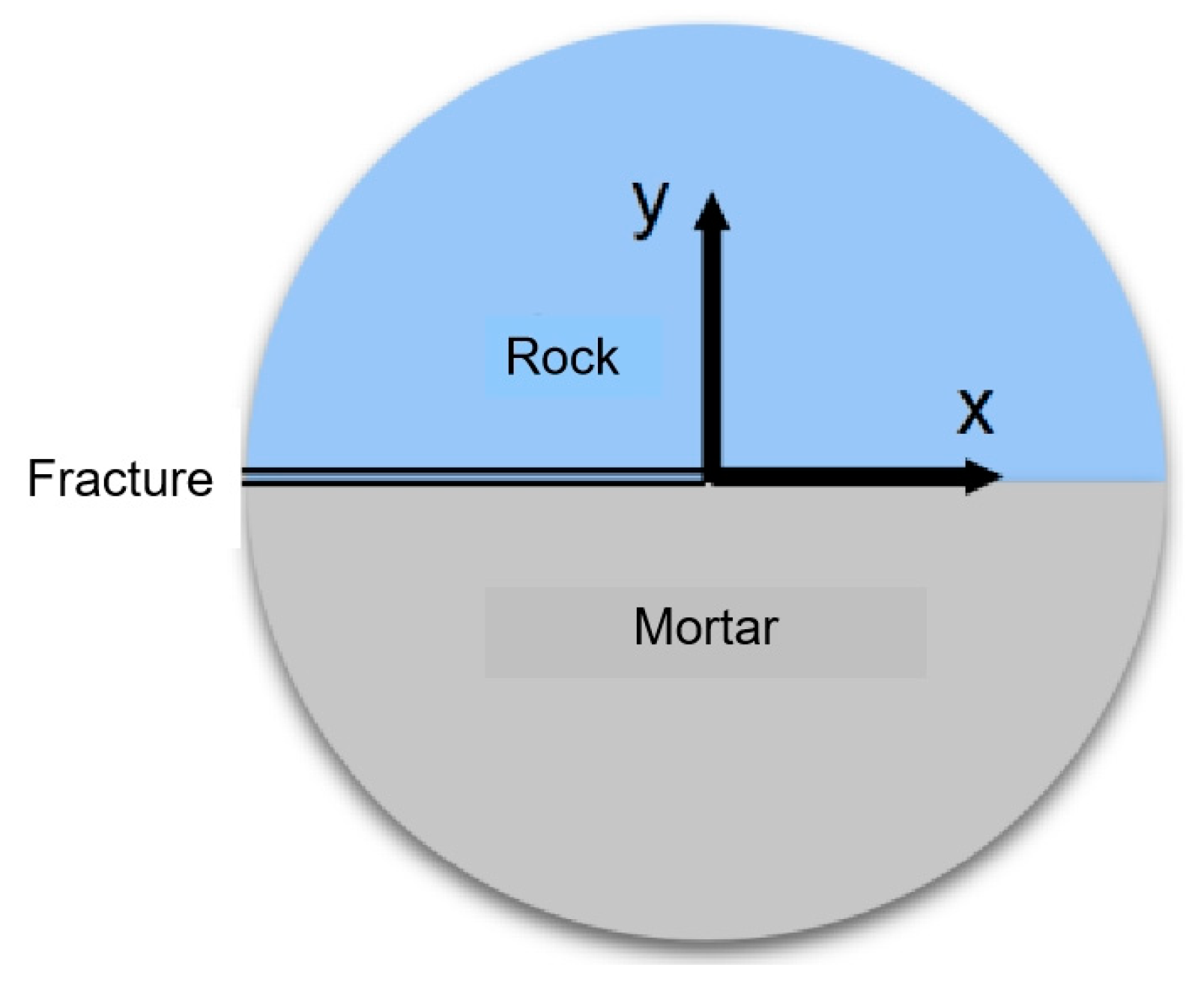


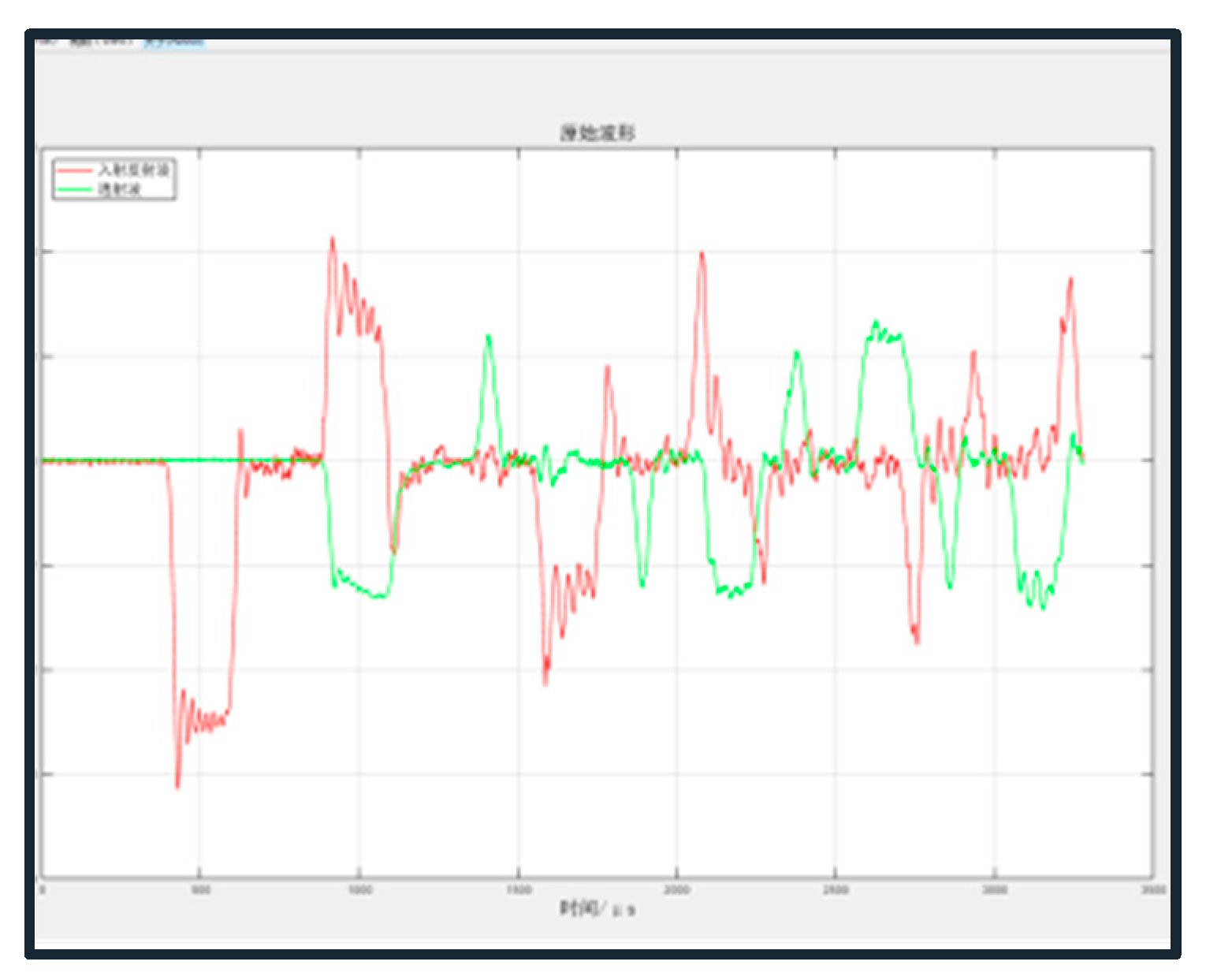
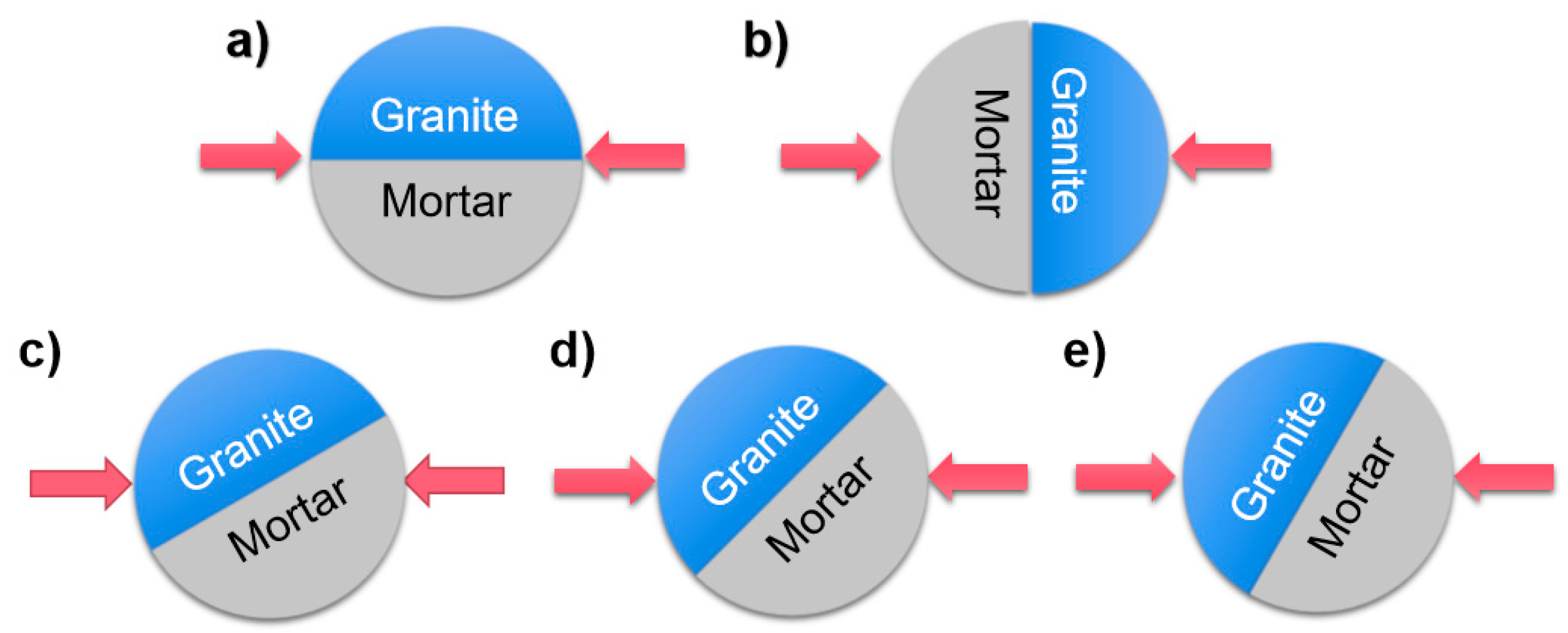

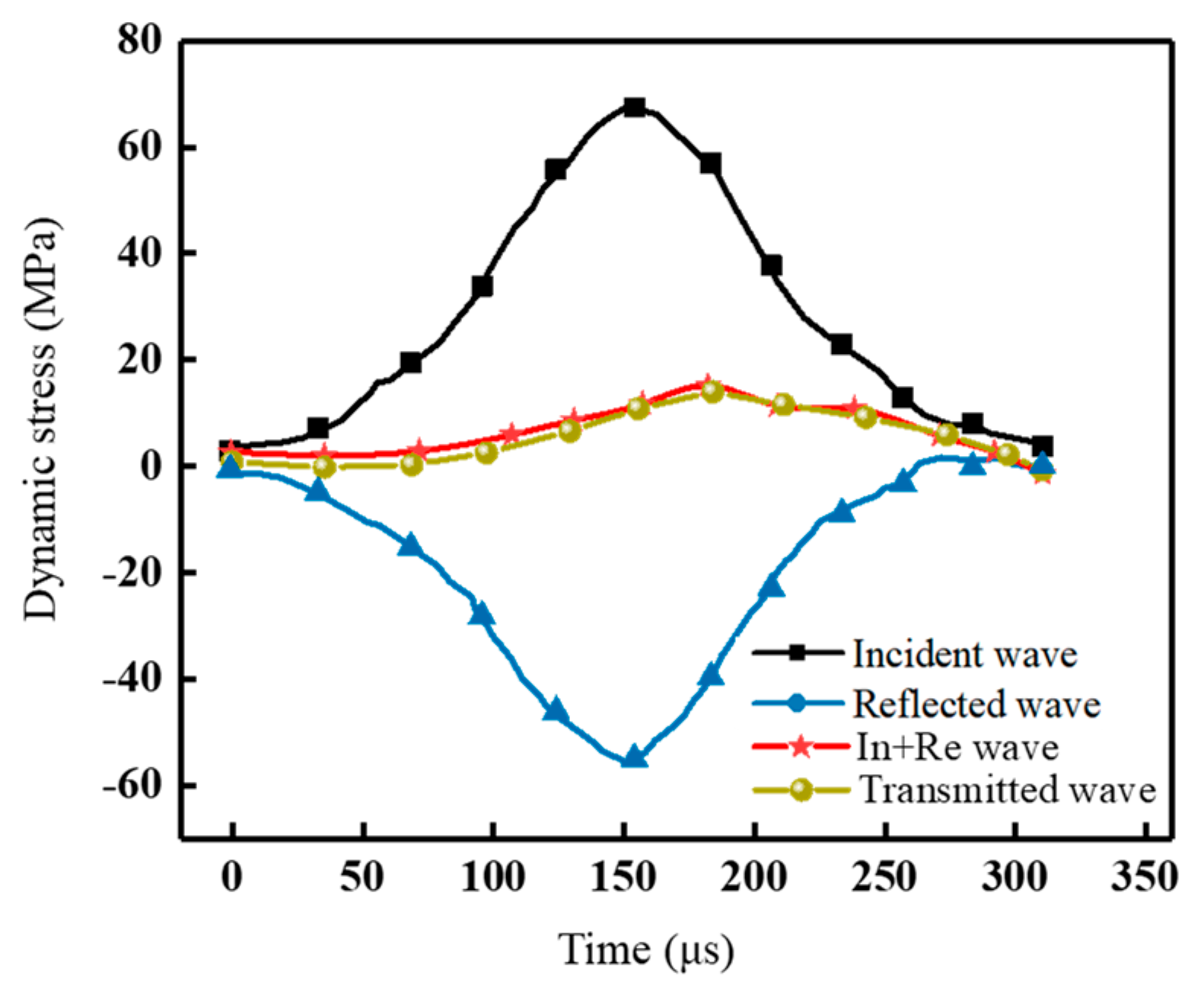

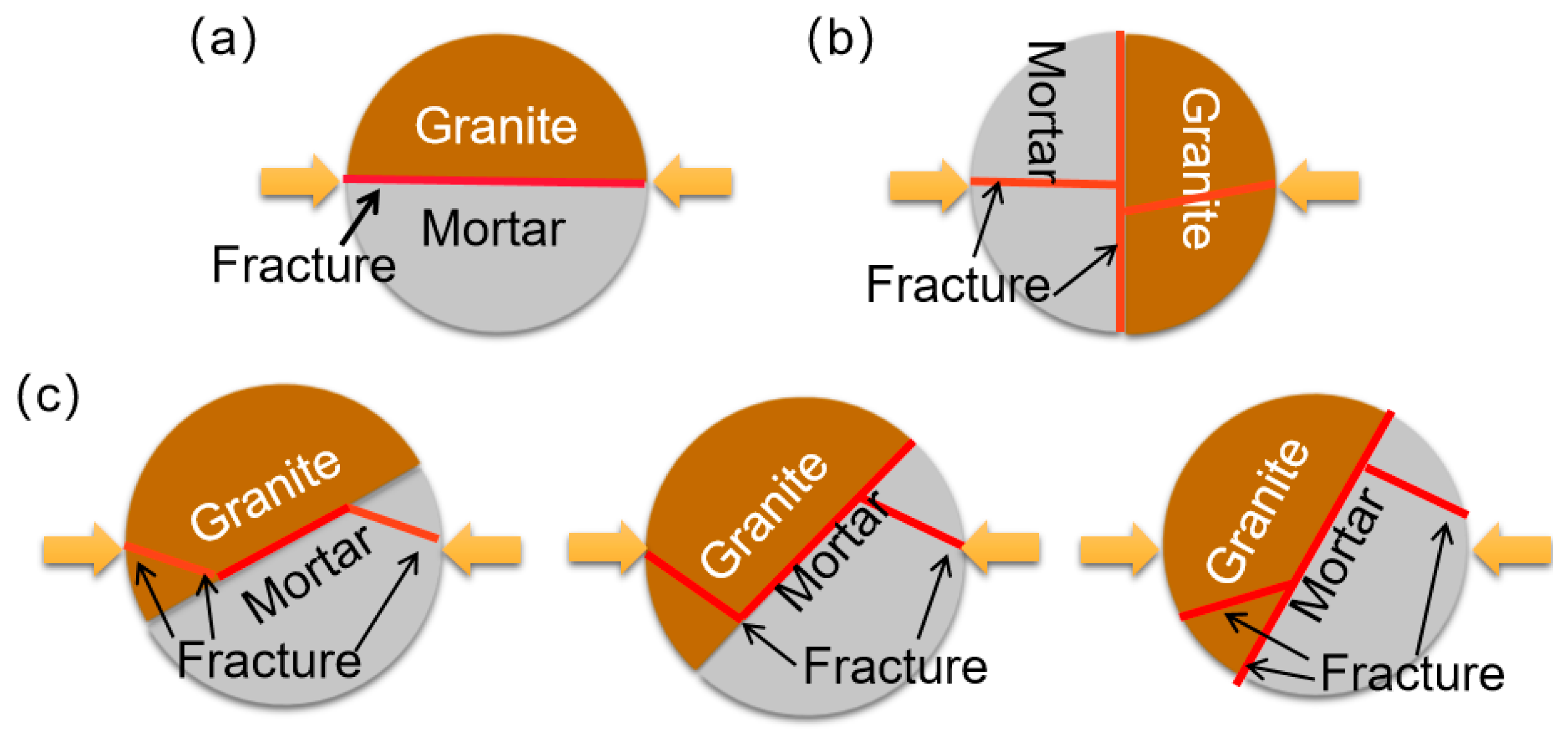
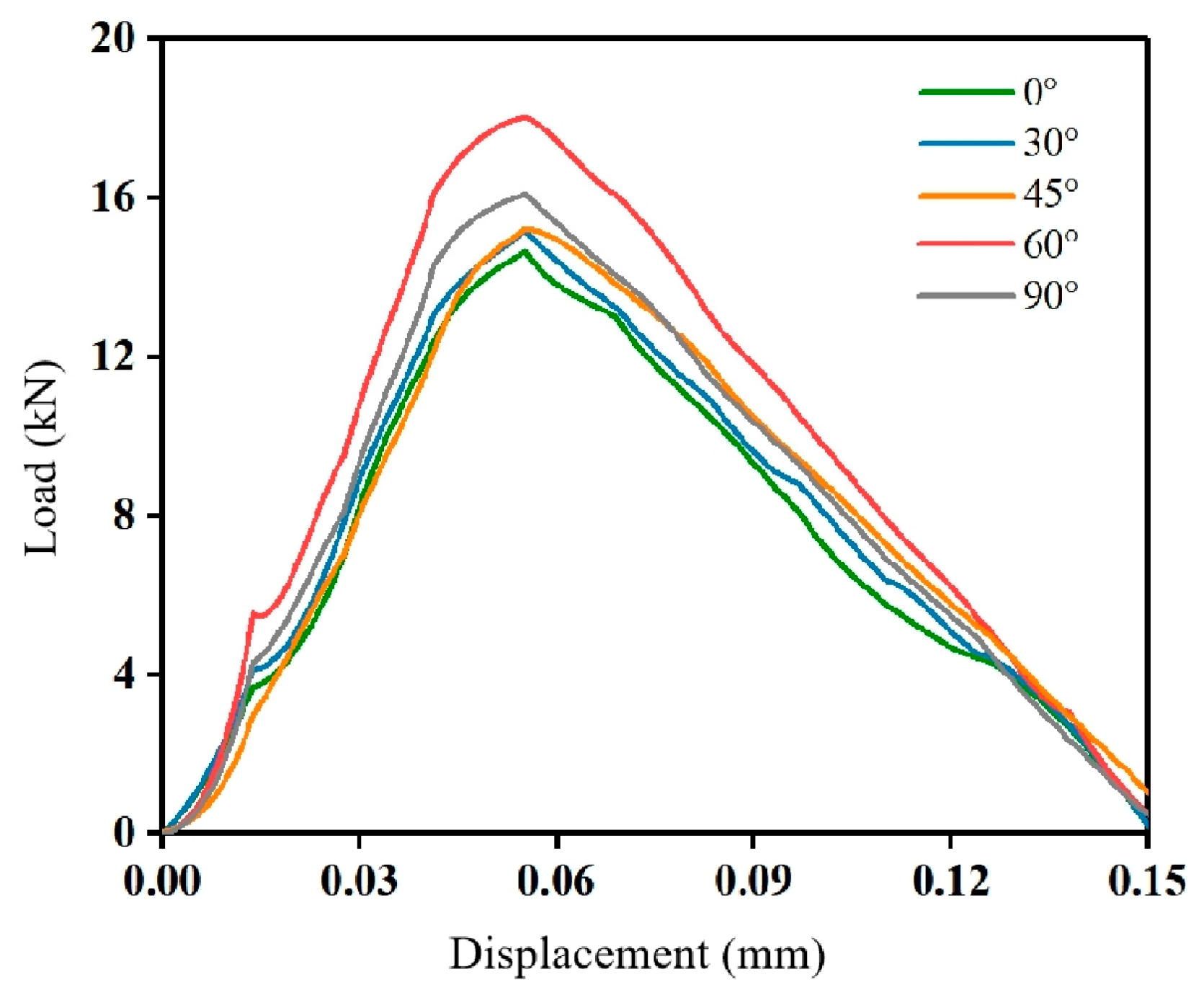
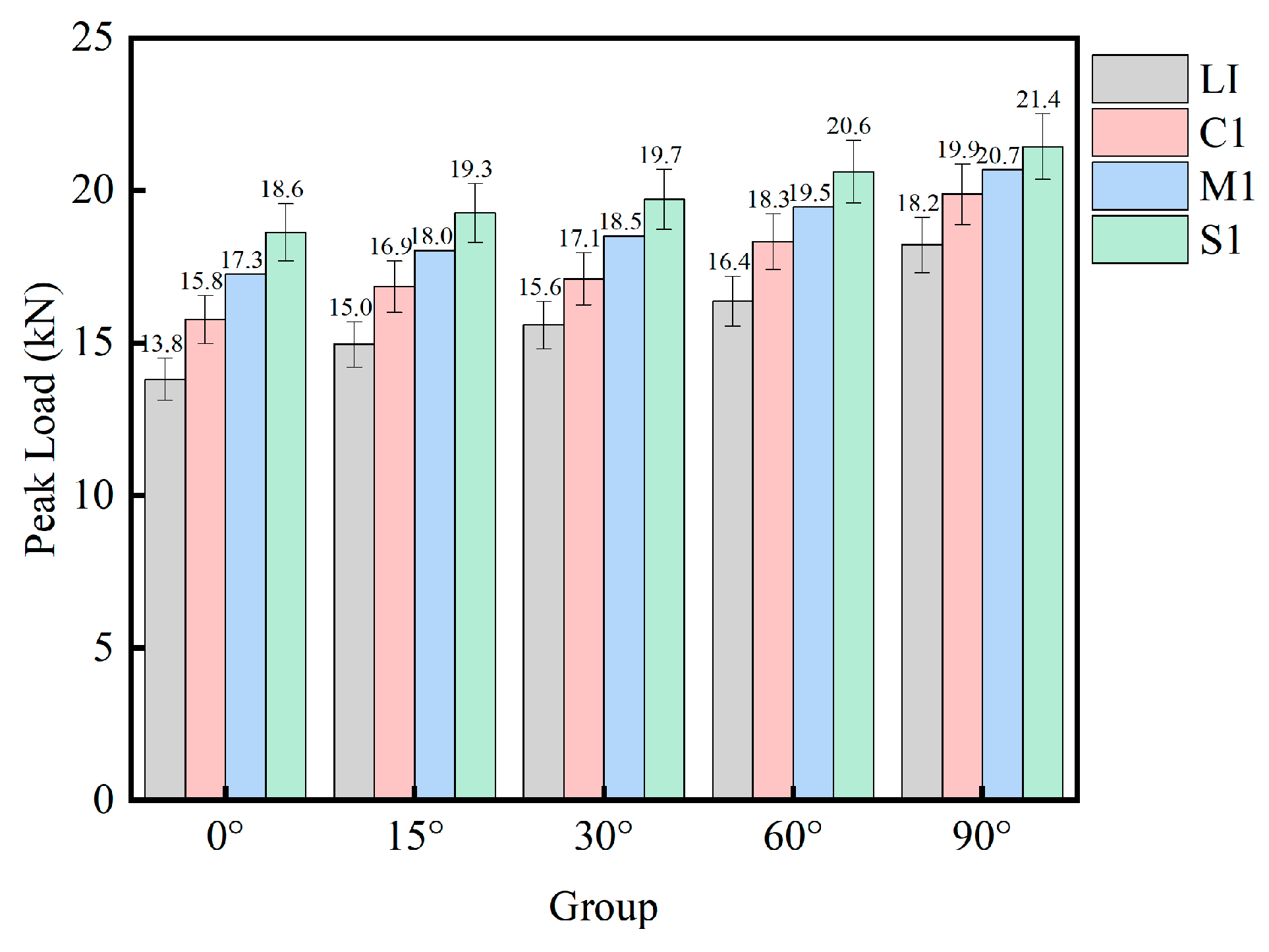
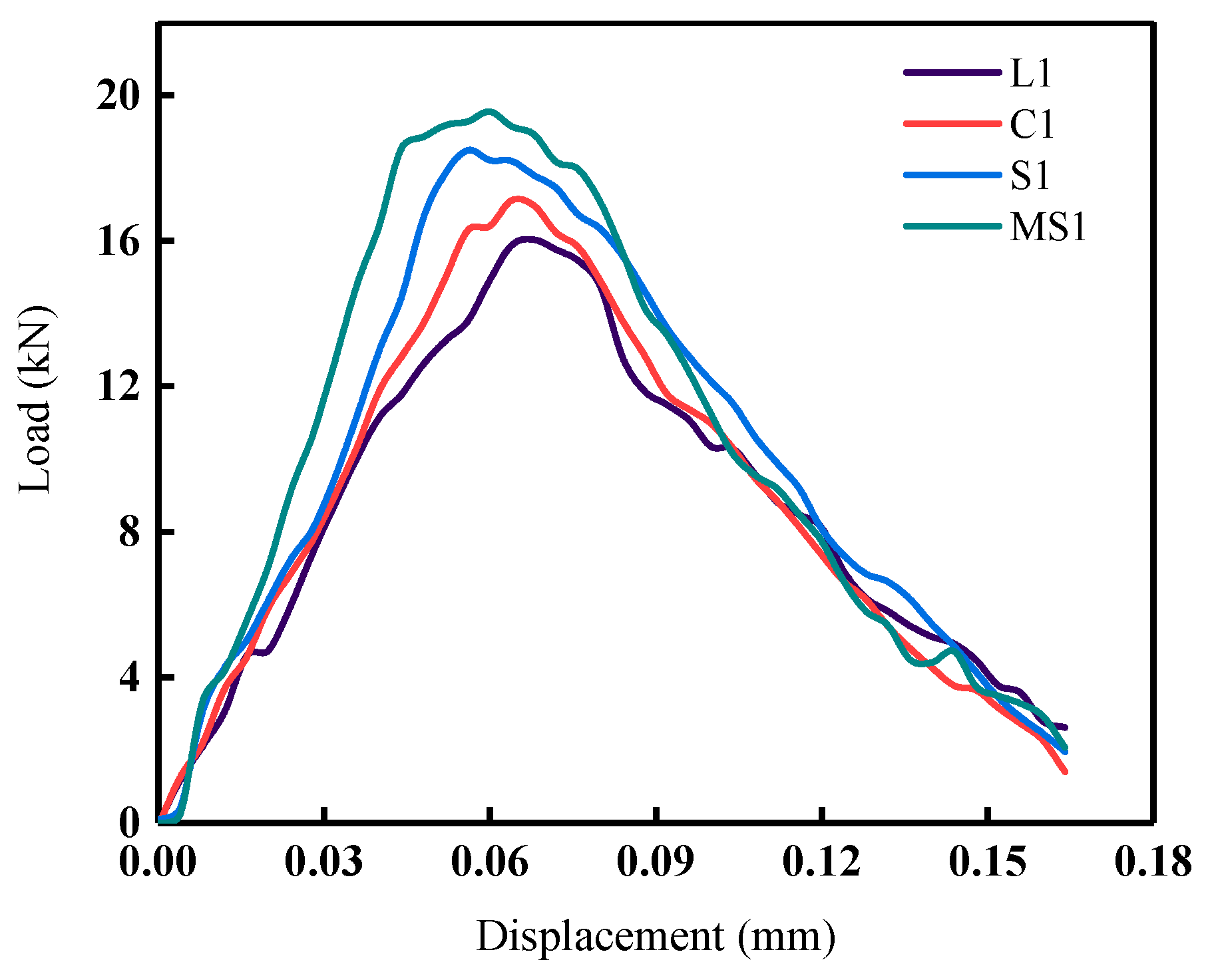



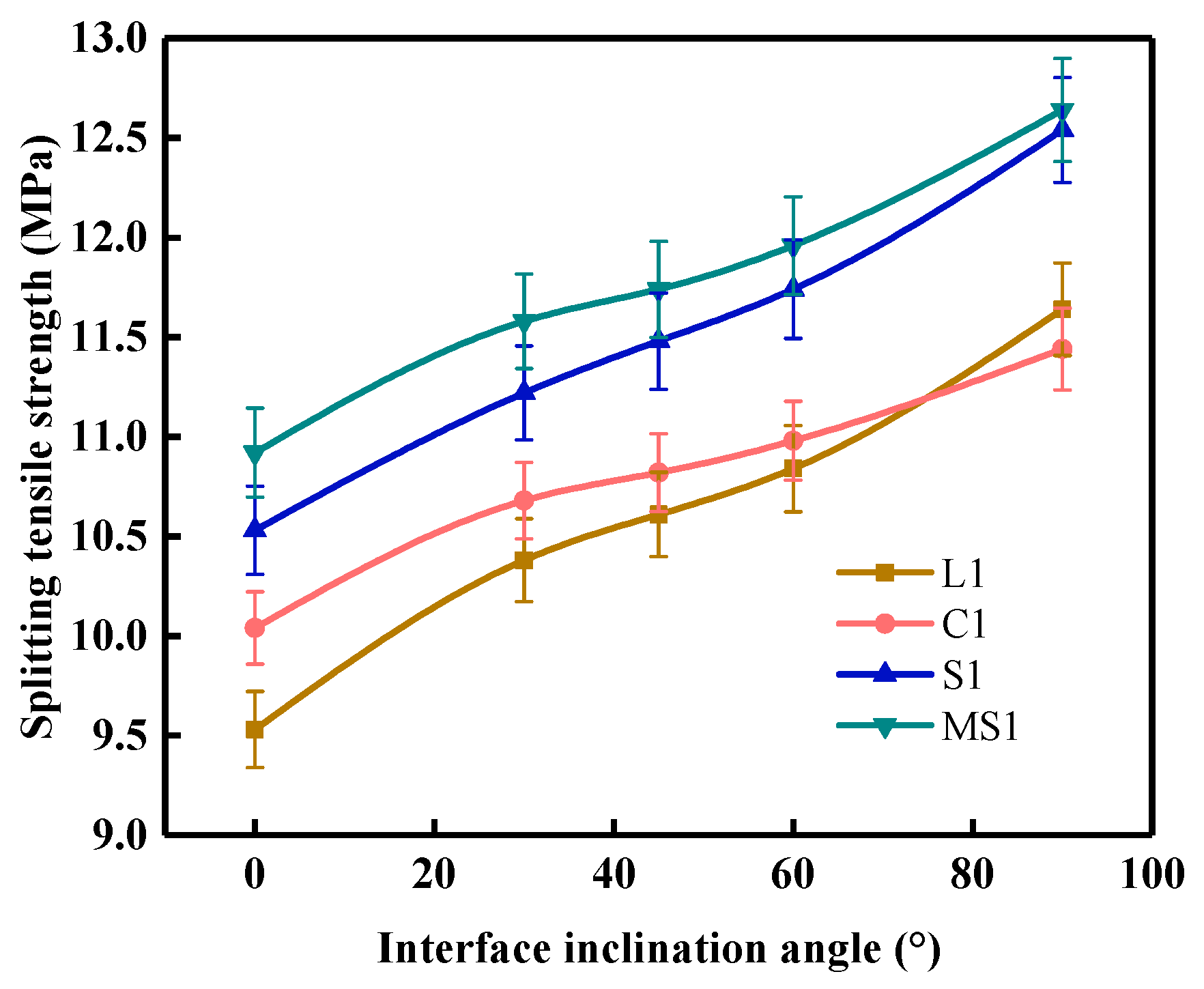

| Type of Aggregate | Compressive Strength/MPa | Elastic Modulus /MPa | Apparent Density /kg·m−3 | Saturated Surface Water Absorption/% | ω/% |
|---|---|---|---|---|---|
| Granite | 150 | 70 | 2850 | 0.46 | 12.8 |
| Grade | Water kg/m3 | Cement kg/m3 | Sand kg/m3 | Silica Fume /% | Additives /% |
|---|---|---|---|---|---|
| M10 | 280 | 250 | 1125 | 5 | 2 |
| Property | Density /g·cm−3 | Compressive Strength/MPa | Flexural Strength /MPa | Setting Time /min | Standard Consistency | |||
|---|---|---|---|---|---|---|---|---|
| 3d | 7d | 3d | 7d | 3d | 7d | |||
| Value | 3.23 | 29.2 | 45.1 | 5.2 | 8.4 | 135 | 205 | 30 |
| Group | Quartz | Albite | Microcline | Biotite |
|---|---|---|---|---|
| Proportion | 46.78 | 31.39 | 20.61 | 1.22 |
| Group | Specimen Size (mm) | Interface Shape | Impact Loading Angle (°) |
|---|---|---|---|
| L1 | Φ48 mm × 25 mm | Straight | 0° |
| L2 | 30° | ||
| L3 | 45° | ||
| L4 | 60° | ||
| L5 | 90° | ||
| CI | Rounded | 0° | |
| C2 | 30° | ||
| C3 | 45° | ||
| C4 | 60° | ||
| C5 | 90° | ||
| S1 | Serrated | 0° | |
| S2 | 30° | ||
| S3 | 45° | ||
| S4 | 60° | ||
| S5 | 90° | ||
| MS1 | Multiserrated | 0° | |
| MS2 | 30° | ||
| MS3 | 45° | ||
| MS4 | 60° | ||
| MS5 | 90° |
| Angle | 0° | 30° | 45° | 60° | 90° |
|---|---|---|---|---|---|
| fs | 3.21 | −4.86 | −3.57 | −2.46 | −1.37 |
Disclaimer/Publisher’s Note: The statements, opinions and data contained in all publications are solely those of the individual author(s) and contributor(s) and not of MDPI and/or the editor(s). MDPI and/or the editor(s) disclaim responsibility for any injury to people or property resulting from any ideas, methods, instructions or products referred to in the content. |
© 2023 by the authors. Licensee MDPI, Basel, Switzerland. This article is an open access article distributed under the terms and conditions of the Creative Commons Attribution (CC BY) license (https://creativecommons.org/licenses/by/4.0/).
Share and Cite
Li, Z.; Dong, J.; Jiang, T.; Feng, K.; Cheng, S.; Liu, Y.; Zhang, G.; Tian, X. Experimental Study on the Dynamic Fracture Characteristics of Mortar–Rock Interface Zones with Different Interface Inclinations and Shapes. Materials 2023, 16, 5475. https://doi.org/10.3390/ma16155475
Li Z, Dong J, Jiang T, Feng K, Cheng S, Liu Y, Zhang G, Tian X. Experimental Study on the Dynamic Fracture Characteristics of Mortar–Rock Interface Zones with Different Interface Inclinations and Shapes. Materials. 2023; 16(15):5475. https://doi.org/10.3390/ma16155475
Chicago/Turabian StyleLi, Zhaoqi, Jie Dong, Tao Jiang, Kai Feng, Siwu Cheng, Yuqian Liu, Guoxiang Zhang, and Xuewei Tian. 2023. "Experimental Study on the Dynamic Fracture Characteristics of Mortar–Rock Interface Zones with Different Interface Inclinations and Shapes" Materials 16, no. 15: 5475. https://doi.org/10.3390/ma16155475
APA StyleLi, Z., Dong, J., Jiang, T., Feng, K., Cheng, S., Liu, Y., Zhang, G., & Tian, X. (2023). Experimental Study on the Dynamic Fracture Characteristics of Mortar–Rock Interface Zones with Different Interface Inclinations and Shapes. Materials, 16(15), 5475. https://doi.org/10.3390/ma16155475





